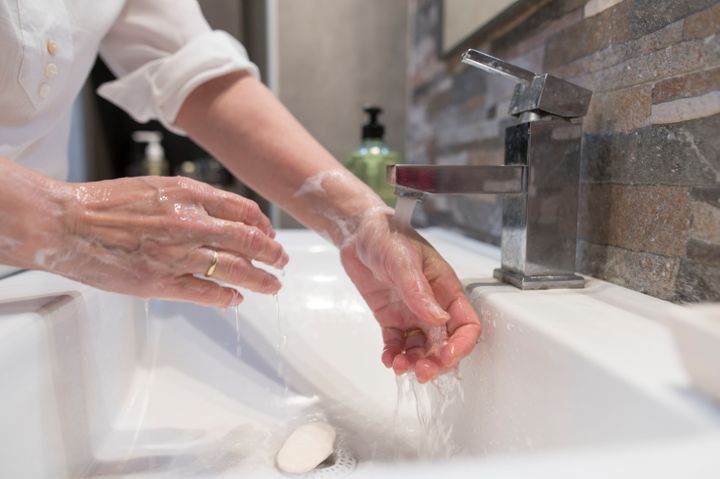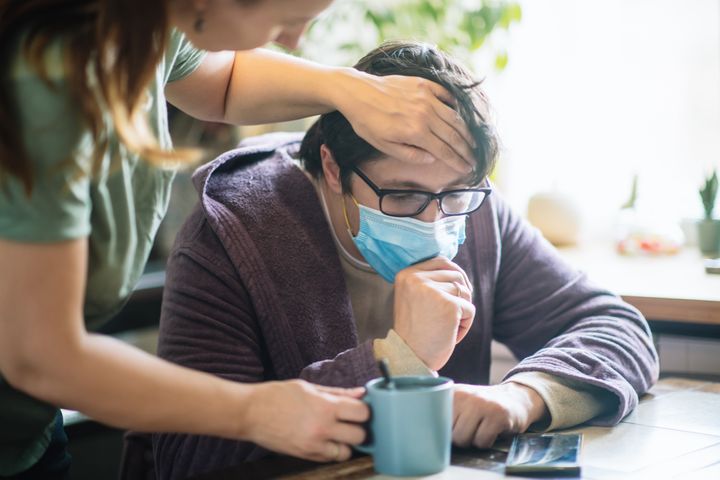News
What It Means If Your Partner Tests Positive For COVID-19 But You Don
It’s easy to assume that if one spouse or partner gets COVID-19, the other is all but fated to get it, too.
But that’s not always true. While studies have shown that the transmission risk of COVID from an infected person to a household contact is common, the risk varies widely. A recent report from the Centers for Disease Control and Prevention showed secondary transmission among close household contacts was 53%. That’s a high rate of transmission, but it also means that almost half of household contacts did not get COVID-19.
Even if the couple is exposed to the same sick person, one might dodge the infection entirely, or may be completely asymptomatic. While health experts are still trying to figure out why some are more susceptible to the virus, there are a few common reasons for this difference in experience.
“First, the viral load for exposure was likely higher for the person who is sick, compared to the person who is not,” said William W. Li, a physician and disease researcher.
Viral load refers to the total amount of virus a person has in their body. In theory, the higher the viral load, the more infectious someone is likely to be.
Let’s say a couple threw caution to the wind and went to a social gathering that was also attended by a COVID-positive person.
Even if a couple were in the same room with the person, their levels of exposure may differ. One partner may have chatted with the person without a mask for more than 15 minutes ― the CDC’s definition of exposure ― while the other may have exchanged greetings and kept their distance for the rest of the night. One may have washed their hands thoroughly while the other didn’t. One might have been wearing a mask, while the other pulled theirs down to talk.
Each of these independent variables determines the likelihood of developing COVID after exposure, Li said.
Secondly, the partners both may be infected by the virus, but one may have an easier time fighting it off thanks to their immune system.
“In this case, the infected but asymptomatic partner may have a more highly powered immune system that is able to battle the virus at the front gate in the body, and keep viral levels low enough so there is not enough to make the person sick,” Li said.
The asymptomatic partner also may have been exposed previously to COVID-19 and developed antibodies or T-cells that effectively protect them against new infection by the partner, Li said. (A seemingly healthy asymptomatic person can still transmit the infection, so it’s important for both partners to continue to social distance and wear a face covering.)
It’s worth noting that even the partner who tests negative could still have COVID-19. Coronavirus tests, especially rapid antigen tests, are not perfect, said Kristin Dean, medical director of Doctor On Demand. The results are dependent on when in the course of the infection you get tested.
“A negative COVID-19 test result is also not 100% accurate, and is known to be less accurate in the first few days after an exposure,” Dean said. “This means that testing too early after exposure increases the possibility of receiving a false negative result, or a negative test result even when you have COVID-19.”
How to protect yourself if your partner gets COVID-19
Once a partner or household contact has a known exposure or tests positive for COVID-19, it’s vital for all household members to wear masks and for the infected individual to self-isolate.
That means staying in a separate room and using a separate bathroom if possible. Barring that, Dean said, you can keep disinfecting wipes in the bathroom and wipe all communal surfaces after use.
Healthy people in the house should wear a mask when around someone who is sick and keep 6 feet away, the CDC advises. After the infected person has had their food, use extreme care cleaning the dishes.
Whenever you come into contact with them, wash your hands thoroughly for at least 20 seconds, the CDC says. (You can also use a hand sanitizer that contains at least 60% alcohol ― just make sure to rub it all around your hands and in between your fingers. Also make sure the solution dries completely before touching anything.)
Be proactive in keeping a clean, sanitary home. Don’t take a defeatist approach to protecting yourself now that one of you is sick, Li said.
“Don’t assume you will automatically get infected or hope that you will so you will ‘get it over with,’” Li added. “In some people, COVID-19 causes long term symptoms that can be disabling, including breath and heart problems, brain fog, and even kidney failure.”

Rachel Patzer, an epidemiologist and the director of health services research at Emory University School of Medicine, stressed this as well. It’s not a foregone conclusion that you’ll get sick.
Patzer has learned this firsthand. Her husband is a frontline health care provider and got COVID several months ago. The family had been vigilant; because of Patzer’s husband’s high risk of contacting the virus, he typically wore a mask indoors, and any time he was around her and their three young children (with the exception of when he was eating and sleeping).
He tested positive for COVID after a known workplace exposure and luckily was able to self-isolate away from his family.
“Other than fatigue and some other lingering symptoms, he was OK after several weeks and neither my children or I got sick with COVID,” Patzer said.
Patzer said the experience was an example of “excellent use of contact tracing, testing at the appropriate time, mask-wearing to prevent transmission, and self-isolation.”
In the end, her family’s ability to stay healthy drove home something Patzer had been saying all along during the pandemic.
“It’s never too late to self-isolate,” she said.
A HuffPost Guide To Coronavirus
As COVID-19 cases rise, it’s more important than ever to remain connected and informed. Join the HuffPost community today. (It’s free!)
Read more

